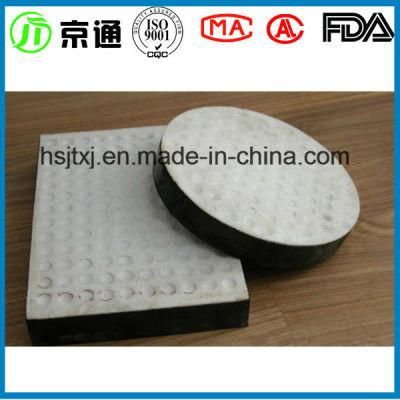
Jingtong Rubber PTFE Sliped Rubber Bridge Bearing
Hengshui Jingtong Rubber Co., Ltd.- Rolling Body:Ball Bearings
- The Number of Rows:Multi-column
- Outer Dimension:Small and Medium-Sized (60-115mm)
- Material:Rubber and Steel Plate
- Main Material:Rubber and Strength Steel Plate
- Shape:Rectangular, Circle
Base Info
- Model NO.:ptfe bridge bearing 209
- Dimension:Customzied
- Offer:Drawing
- Package:Wovenbag and on Pallet
- Origin Place:Hengshui, China
- Applocation:Bridge and Construction
- Brand:Jingtong Rubber
- Urgent Order:Yes
- Business Type:Factory Manufacture
- Usage:Support
- Certification:BV, CE, ISO
- Customized:Customized
- Transport Package:Wovenbag and Pallet
- Specification:ISO, CE, SGS
- Trademark:JINGTONG
- Origin:China
- HS Code:4016909090
- Production Capacity:500000PCS ,Year
Description
Basic Info.
Model NO. ptfe bridge bearing 209 Dimension Customzied Offer Drawing Package Wovenbag and on Pallet Origin Place Hengshui, China Applocation Bridge and Construction Brand Jingtong Rubber Urgent Order Yes Business Type Factory Manufacture Usage Support Certification BV, CE, ISO Customized Customized Transport Package Wovenbag and Pallet Specification ISO, CE, SGS Trademark JINGTONG Origin China HS Code 4016909090 Production Capacity 500000PCS /YearProduct Description
PTFE sliped rubber bridge bearing, as its name implies, has a layer of virgin dimpled PTFE bonded to the laminated elastomeric bearing to reduce the sliding resistance and improve the structure's displacements capacity.Features:
PTFE sliped rubber bridge bearing:
Allow movements bigger than shear capability in plain surface.
PTFE sliding surface with lubricants to reduce the friction coefficient.
With dimples on PTFE for contain lubricant to ease the sliding movements.
Excellent buffering and shock isolation.
Withstand vertical load and suit to rotations of beam ends.
In accordance with European standard EN 1337-2 or other international standards.
Available in various shapes such as rectangular or round.
Applications:
Bridges with large spans, continuous spans, simply supported beam, continuous plate structures or large displacements.
Support structures requiring less vertical but more horizontal weight.
Details:
Materials: neoprene, natural rubber or SBR with PTFE top surface.
Standard: BS EN 1337-2
Thickness of PTFE: 1.5 mm to 3 mm or others as your request.
Thickness: 1/8" to 30" or custom thickness.
Width: 36" to 48" or custom widths.
Shapes: rectangular or round.
Certifications:
Our products are manufactured in accordance with all of the international standards, including BS EN1337, AASHO, KS4424, ISO, etc. Bridge bearing complying with custom standards can also be supplied by our company.
Related Products:
There are ten main types of bridges bearings are supplied to meet your different needs. Some specific designs are also available as your request.
Laminated elastomeric bearing is manufactured through the process of vulcanization and moulding to form a homogeneous unit with layers of steel plated embedded in. Comparing with plain elastomeric bearing, this one has higher vertical load capacity, excellent vibration and sound isolation. It is ideal for bridges with short span and flyovers, etc.
PTFE top elastomeric bearing, a variation of traditional laminated elastomeric bearing, features a layer of PTFE bonded to top surface of the bearing. In conjunction with lubricant in the dimples of PTFE, the bearing allows for excellent sliding movements with reduced friction coefficient.
Elastomeric bearing with steel plate is reinforced with outer steel plates vulcanized directly onto the surface of rubber pad. It can be manufactured with holes or pins for easy fastening. They are ideal for in-situ concrete structure, metal structures and anti-life device, etc. To suit your scheme, six types can be provided by our company.
Plain elastomeric bearing with the simplest structure among all bearing products is exclusively manufactured from natural rubber or neoprene rubber. It is considered to be a low cost choice for short span bridges, prefabricated structures, buildings as well as flyovers, etc.
Pot bearing, is the widest used type designed for structures using the incremental launching methods, highways and railways, etc. PTFE top elastomeric bearing is fitted in the steel pot plate to ease the sliding movements with the help of a stainless steel panel welded on top steel plate.
Spherical bridge bearing features its precision-machined steel plates with concave ad convex surfaces. And it can accommodate large movements and rotations in excess of +/- 0.03 radians. Spherical bridge bearings can be applied to structures with large turning angles, wide and curved bridges regardless of low temperatures even under -30ºC.
Disc bridge bearing features polyurethane disc with excellent chemical resistance, corrosion resistance regardless of various environmental influences. It can bear higher stress than traditional pot bearing and transfer shear forces owing to its threaded shear pin.
Lead rubber bearing, as its name implies, has a lead plug in the middle of the bearing that will assist the bearing to absorb earthquake-generated forces, extending the structure vibration period. In this way, lead rubber bearings protect buildings or structures from damages and severe deformations caused by earthquake.
High damping rubber bearing, manufactured from quality rubber with great damping ability and high durability, is also a seismic isolator similar to lead rubber bearing without the central lead plug.
Rocker bearings, with stainless steel pins are capable to absorb living load, constant load, compression and shear forces by providing stable movements and rotations. With high earthquake-proof property, it can be applied to areas with high seismic intensity up to 9 degrees.
